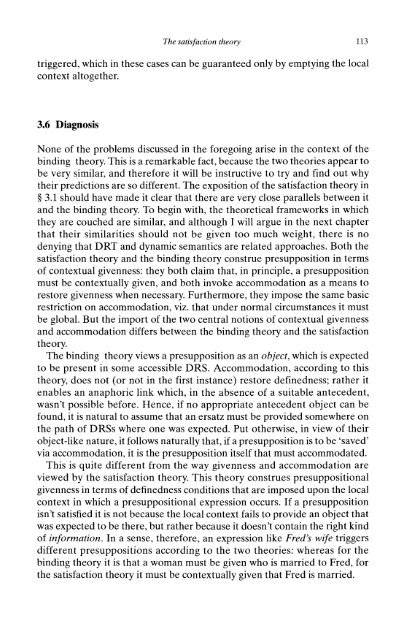Presuppositions and Pronouns - Nijmegen Centre for Semantics
Presuppositions and Pronouns - Nijmegen Centre for Semantics
Presuppositions and Pronouns - Nijmegen Centre for Semantics
You also want an ePaper? Increase the reach of your titles
YUMPU automatically turns print PDFs into web optimized ePapers that Google loves.
The satisfaction theory 113<br />
triggered, which in these cases can be guaranteed only by emptying the local<br />
context altogether.<br />
3.6 Diagnosis<br />
None of the problems discussed in the <strong>for</strong>egoing arise in the context of the<br />
binding theory. This is a remarkable fact, because the two theories appear to<br />
be very similar, <strong>and</strong> there<strong>for</strong>e it will be instructive to try <strong>and</strong> find out why<br />
their predictions are so different. The exposition of the satisfaction theory in<br />
§ 3.1 should have made it clear that there are very close parallels between it<br />
<strong>and</strong> the binding theory. To begin with, the theoretical frameworks in which<br />
they are couched are similar, <strong>and</strong> although I will argue in the next chapter<br />
that their similarities should not be given too much weight, there is no<br />
denying that DRT <strong>and</strong> dynamic semantics are related approaches. Both the<br />
satisfaction theory <strong>and</strong> the binding theory construe presupposition in terms<br />
of contextual givenness: they both claim that, in principle, a presupposition<br />
must be contextually given, <strong>and</strong> both invoke accommodation as a means to<br />
restore givenness when necessary. Furthermore, they impose the same basic<br />
restriction on accommodation, viz. that under normal circumstances it must<br />
be global. But the import of the two central notions of contextual givenness<br />
<strong>and</strong> accommodation differs between the binding theory <strong>and</strong> the satisfaction<br />
theory.<br />
The binding theory views a presupposition as an object, which is expected<br />
to be present in some accessible DRS. Accommodation, according to this<br />
theory, does not (or not in the first instance) restore definedness; rather it<br />
enables an anaphoric link which, in the absence of a suitable antecedent,<br />
wasn't possible be<strong>for</strong>e. Hence, if no appropriate antecedent object can be<br />
found, it is natural to assume that an ersatz must be provided somewhere on<br />
the path of DRSs where one was expected. Put otherwise, in view of their<br />
object-like nature, it follows naturally that, if a presupposition is to be 'saved'<br />
via accommodation, it is the presupposition itself that must accommodated.<br />
This is quite different from the way givenness <strong>and</strong> accommodation are<br />
viewed by the satisfaction theory. This theory construes presuppositional<br />
givenness in terms of definedness conditions that are imposed upon the local<br />
context in which a presuppositional expression occurs. If a presupposition<br />
isn't satisfied it is not because the local context fails to provide an object that<br />
was expected to be there, but rather because it doesn't contain the right kind<br />
of in<strong>for</strong>mation. In a sense, there<strong>for</strong>e, an expression like Fred's wife triggers<br />
different presuppositions according to the two theories: whereas <strong>for</strong> the<br />
binding theory it is that a woman must be given who is married to Fred, <strong>for</strong><br />
the satisfaction theory it must be contextually given that Fred is married.














